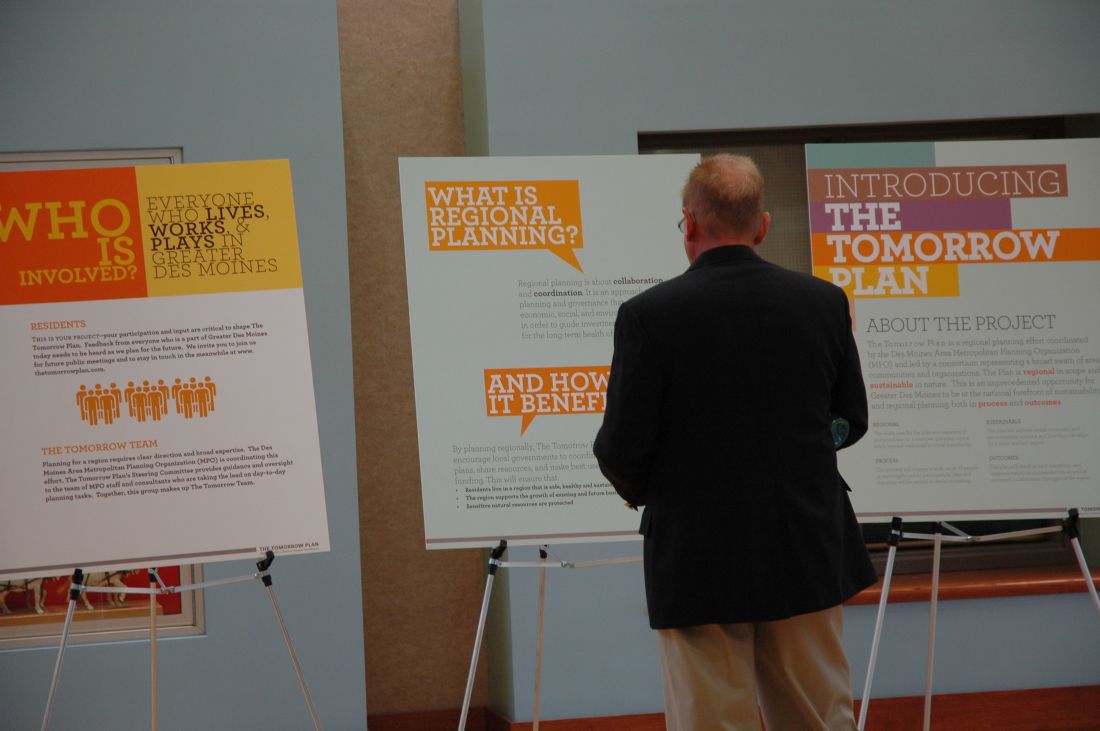
IN THIS ISSUE:
UC Davis Opens Doors to West Village, Aims to Be Largest Zero Net Energy Facility in U.S.
Philly Food Bucks: Philadelphia’s Healthy Eating Program
Grantee Spotlight: The Tomorrow Plan of the Central Iowa Region
The Lofts at Reynoldstown Crossing
Grantee Spotlight: The Tomorrow Plan of the Central Iowa Region

The Tomorrow Plan was officially launched in July 2011. This action marks the first time in Iowa’s history that major planning components are being integrated into a comprehensive, forward-thinking regional plan. Image courtesy of the Des Moines Area Metropolitan Planning Organization.
In 2010, the Greater Des Moines region — a 542 square-mile area that includes the city of Des Moines and 18 surrounding communities in Central Iowa — was at a crossroads. With population in Greater Des Moines projected to increase from 570,000 in 2010 to 650,000 by the year 2035, the region faced a number of challenges: increased auto dependency placing strain on its existing road system, rising housing costs, periodic water shortages, and loss of agricultural land due to urban sprawl. Responding to these current and anticipated challenges, local leaders are now in the process of developing a comprehensive, coordinated regional plan to determine how the Central Iowa region can best accommodate future growth. Des Moines is among the 143 regions and communities to receive HUD Sustainable Communities Initiative funding, as part of the Partnership for Sustainable Communities. The region received a $2.2 million grant in October 2010 to create a comprehensive regional housing, environmental and land use plan.
The Tomorrow Plan
Launched in July 2011, The Tomorrow Plan incorporates planning strategies and implementation measures that will guide the region’s growth through 2050. The 20-month planning process has five phases. The first phase, creating a public participation process for the community to voice concerns and provide input, was completed in September 2011. Now in the second phase, the regional planning consortium—led by the Des Moines Area Metropolitan Planning Organization (MPO) with partners including local jurisdictions, the regional transit authority, the Community Foundation, and University of Iowa—will analyze existing economic, transportation, and environmental plans (as well as demographic and development data) to project plausible future trends through 2050.
The third phase will involve generating and testing regional growth scenarios to identify the pros and cons of each, and comparing these scenarios with a baseline or “business as usual” approach to gauge the potential effects. In the fourth phase, the results of the previous “compare and contrast” exercise will be used to further develop and refine the plan’s direction and to identify action items and strategies for the various plan components.
The fifth and final phase will consist of merging all plan components into a single comprehensive, regional sustainable development plan, complete with all the steps required for implementation. Assuming the work remains on schedule, the MPO estimates a February 2013 completion date.
Looking Ahead
“We do not know what The Tomorrow Plan will recommend; the beauty of the [Plan] is that the public is shaping it,” explains project manager Bethany Wilcoxon. A key challenge, Wilcoxon says, is engaging communities and groups that are often left out of the planning process, such as rural landowners, low-income and immigrant communities, and households in which English is not the primary language. To address these concerns, the MPO is hosting a series of talks in advance of seeking direct input and partnering with multiple community groups and organizations, including the faith-based community, to reach out to those who are not normally involved in the planning process. By continuously engaging the public and partnering with other regional stakeholders, the consortium is making great progress toward achieving a comprehensive plan shaped and informed by central Iowans that will support sustainable growth in the region over the next 40 years.
About the Partnership for Sustainable Communities
The Partnership for Sustainable Communities, a collaboration between the U.S. Department of Housing and Urban Development, the U.S. Department of Transportation, and the U.S. Environmental Protection Agency, coordinates federal housing, transportation, water, and other infrastructure investments to make neighborhoods more prosperous, allow people to live closer to their jobs, save households time and money, and reduce pollution. For more on the Partnership, including the six livability principles that guide its work, please visit our website. This past October, the Office of Sustainable Housing and Communities held a grantee convening for all 2010 grantees. More than 300 representatives from 85 of the 87 grantees gathered to share insights from their planning processes and hear keynote remarks from HUD Secretary Shaun Donovan. Recipients of the 2011 HUD Sustainable Communities Grants were announced this past November.
